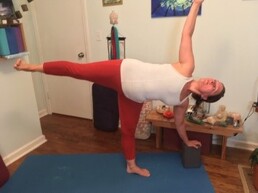|
6/10/2022 0 Comments Developing An Athlete's Balance Ardha Chandrasana - Half-Moon Pose Ardha Chandrasana - Half-Moon Pose Athletes know that four of the main types of exercises are balance, strength, endurance, and flexibility. In many sports, balance is one of the most under-rated, often being overlooked in workouts in favor of the other three. So what is balance and how do we achieve it? Merriam Webster lists many different definitions, but for athletic and yogic purposes, we generally refer to physical equilibrium—the ability to balance and not fall over; to mental and emotional steadiness; and to finding a happy medium between conflicting or interacting elements. It is widely known that one of the most common predictors of injury is muscular imbalance. Yoga combats this by constantly working towards muscular balance—every movement and posture is practiced bilaterally and is geared towards balancing effort and relaxation. Additionally, yoga helps develop our actual balance (physical equilibrium) by challenging our sensorimotor control systems. Specifically, yoga challenges our vestibular system, our sight, and our proprioceptive awareness. Many movements or postures such as vinyasas and inversions stimulate the vestibular organs, while the twisting and turning of the neck and head challenge the sensory input our brain receives from our eyes. Strong, balanced muscles, good proprioceptive awareness, and healthy eyes and vestibular organs lead to less falls and less injuries. Just as importantly, yoga works to balance the two nervous systems and hemispheres of the body. It recalibrates the brain. In the modern world of constant stress and overstimulation, young athletes need as much attention to this area as any adult. Yoga begins by calming the breath because it is easier to calm the breath than the mind. In his book titled One Simple Thing, yoga teacher Eddie Stern says, “If stress levels are high, yoga practice will down-regulate, particularly through breathing, the parts of the brain and endocrine system that are responsible for hormonal release of adrenaline and cortisol.... (Yoga) restores the functions that are out of alignment toward a state of balance.” (74)
0 Comments
 Way marker for the Camino de Santiago, showing items pilgrims have left behind to symbolize letting go of baggage. Way marker for the Camino de Santiago, showing items pilgrims have left behind to symbolize letting go of baggage. Young student athletes may not realize it yet, but parents in competitive youth sports know that even though the days are long, the years fly by. If we know this, then why don’t we learn to savor the little moments of the sports journey instead of rushing about from one thing to the next, cramming as many things into a day as possible? When we strive for efficiency just to achieve more (rather than as a means to free up time for hobbies and quality time), then efficiency is just code for pressure. And the pressure we have created here in the US has spread around the world. Recently I met some friends from Guadalajara, Mexico whose children attend the American School there—a bilingual private school that issues both a Mexican and a U.S. high school diploma. Although they are Mexicans living in Mexico, my new friends said, their kids are expected to keep up with the pace of the American academic system, applying to dozens of universities and participating in multiple sports and activities. It’s all about standing out from the competition. I am a highly sensitive recovering perfectionist who suffers from anxiety and is easily overstimulated. As such, competition is a chronic stressor for me. While I have implemented many tools to be less bothered by others' words and actions and to stay grounded in my own journey, many days are still a struggle. Do more, be more, buy more, the world around us says. When the pace of growth and information overload makes our bodies and minds suffer, it’s time to step away from the competition and courageously and honestly give ourselves a reset. What kind of reset? Sometimes a reset may look like embodiment practices such as restorative yoga, conscious breathing, and walking in nature. Other times it may look like journaling, meditation, and talk therapy. Even other times, though, that reset might look like a dramatic change of scenery. Over twenty years ago I learned that one of the best ways for me to reset my nervous system—bring it back into balance—after chronic overwhelm was to get far away from the outside influences and expectations pulling me in all directions. I like to go far enough away that it’s clear to myself and others that communication will be minimal while I’m away. If you or others have a hard time respecting your boundaries, or if you are easily overwhelmed by competing demands, this type of physical distance can be a helpful tool for a personal reset. To be clear— getting away is never an escape from your problems long-term. You must do deep work on yourself for any change to be lasting. Mindful travel, however, is an opportunity to reset your nervous system out of fight or flight mode and to help you see things through a different lens. To this end, I decided to travel to Spain to walk the Camino de Santiago. |
Author // the skating yogiMy name is Sarah Neal. I have been immersed in the world of figure skating for over four decades. I have seen firsthand the abuse that happens at the higher levels of our sport and experienced how that trickles down into unhealthy training practices and habits at the grassroots. I have seen this play out in the operations of the very institutions that control our sport. Whether for a profession or hobby, pursuing skating should be a joyful, rewarding process, an opportunity for athletic and personal growth, and a place to build lasting friendships. Archives
March 2024
CategoriesAll Athlete Well Being Athlete Well-Being Deep Connections Embodied Movement And Meditation Practices Life After Competition Mindful Living |
Search by typing & pressing enter

 RSS Feed
RSS Feed